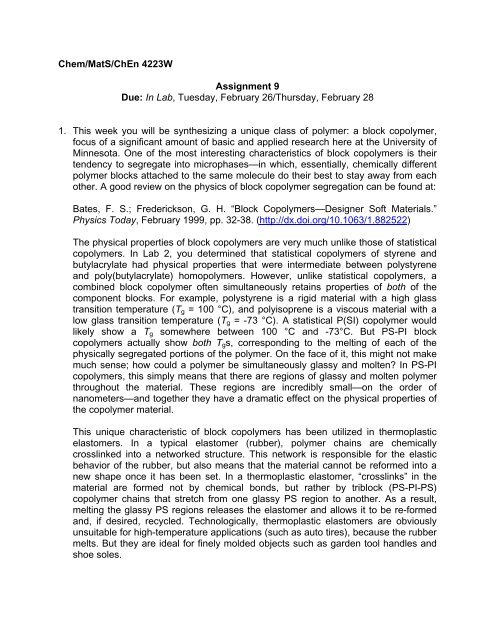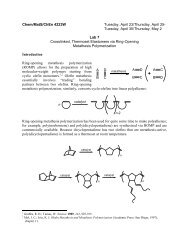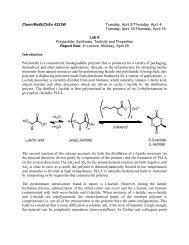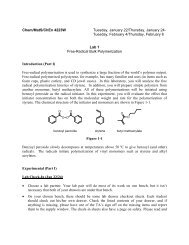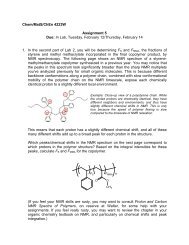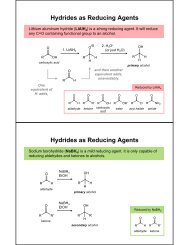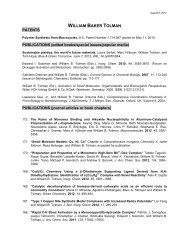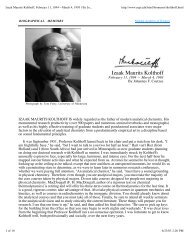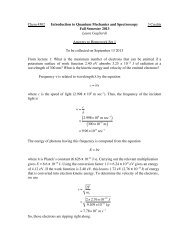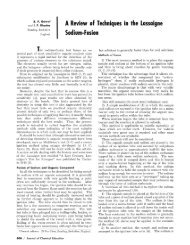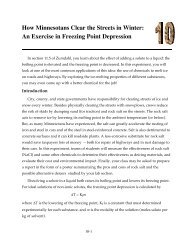Chem/MatS/ChEn 4223W Assignment 9 Due: In Lab, Tuesday ...
Chem/MatS/ChEn 4223W Assignment 9 Due: In Lab, Tuesday ...
Chem/MatS/ChEn 4223W Assignment 9 Due: In Lab, Tuesday ...
You also want an ePaper? Increase the reach of your titles
YUMPU automatically turns print PDFs into web optimized ePapers that Google loves.
<strong>Chem</strong>/<strong>MatS</strong>/<strong>ChEn</strong> <strong>4223W</strong><strong>Assignment</strong> 9<strong>Due</strong>: <strong>In</strong> <strong>Lab</strong>, <strong>Tuesday</strong>, February 26/Thursday, February 281. This week you will be synthesizing a unique class of polymer: a block copolymer,focus of a significant amount of basic and applied research here at the University ofMinnesota. One of the most interesting characteristics of block copolymers is theirtendency to segregate into microphases—in which, essentially, chemically differentpolymer blocks attached to the same molecule do their best to stay away from eachother. A good review on the physics of block copolymer segregation can be found at:Bates, F. S.; Frederickson, G. H. “Block Copolymers—Designer Soft Materials.”Physics Today, February 1999, pp. 32-38. (http://dx.doi.org/10.1063/1.882522)The physical properties of block copolymers are very much unlike those of statisticalcopolymers. <strong>In</strong> <strong>Lab</strong> 2, you determined that statistical copolymers of styrene andbutylacrylate had physical properties that were intermediate between polystyreneand poly(butylacrylate) homopolymers. However, unlike statistical copolymers, acombined block copolymer often simultaneously retains properties of both of thecomponent blocks. For example, polystyrene is a rigid material with a high glasstransition temperature (T g = 100 °C), and polyisoprene is a viscous material with alow glass transition temperature (T g = -73 °C). A statistical P(SI) copolymer wouldlikely show a T g somewhere between 100 °C and -73°C. But PS-PI blockcopolymers actually show both T g s, corresponding to the melting of each of thephysically segregated portions of the polymer. On the face of it, this might not makemuch sense; how could a polymer be simultaneously glassy and molten? <strong>In</strong> PS-PIcopolymers, this simply means that there are regions of glassy and molten polymerthroughout the material. These regions are incredibly small—on the order ofnanometers—and together they have a dramatic effect on the physical properties ofthe copolymer material.This unique characteristic of block copolymers has been utilized in thermoplasticelastomers. <strong>In</strong> a typical elastomer (rubber), polymer chains are chemicallycrosslinked into a networked structure. This network is responsible for the elasticbehavior of the rubber, but also means that the material cannot be reformed into anew shape once it has been set. <strong>In</strong> a thermoplastic elastomer, “crosslinks” in thematerial are formed not by chemical bonds, but rather by triblock (PS-PI-PS)copolymer chains that stretch from one glassy PS region to another. As a result,melting the glassy PS regions releases the elastomer and allows it to be re-formedand, if desired, recycled. Technologically, thermoplastic elastomers are obviouslyunsuitable for high-temperature applications (such as auto tires), because the rubbermelts. But they are ideal for finely molded objects such as garden tool handles andshoe soles.
A good source of reading on these materials:Holden, G. Understanding Thermoplastic Elastomers (Hanser Gardner, Cincinnati,2000), pp. 1-52. (On reserve, Walter Library.)You can also read more about commercial PS-PI-PS triblock elastomers at Kraton(http://www.kraton.com/) and Dexco (http://www.dexcopolymers.com/), twocompanies that specialize in block copolymer materials.Draw a cartoon that best illustrates the structural difference between chemicallycrosslinked and thermoplastic elastomers, representing the polymer chains as linesand squiggles. <strong>In</strong> both cases, also draw cartoons that show how the elastomerresponds to elongation.
2. You will be synthesizing your polymers by living, anionic polymerization, a methodwhich is exceptional for its control over molecular weight and monodispersity. Youmay want to review a text chapter on anionic polymerization (e.g., Odian) beforedoing <strong>Lab</strong> 4.One of the great characteristics of anionic polymerization is its relative predictability;because initiation and polymerization are perfectly efficient, it is easy to target aparticular molecular weight product and then achieve that molecular weight. <strong>In</strong> thislab, you will synthesize your first polystyrene homopolymer/block with a targetmolecular weight determined by your pair number:pair numberPS block length (g/mol)1,2,9,10 4,0003,4,11,12 5,0005,6,13,14 6,0007,8,15,16 7,000Before you come to lab, you will need to calculate the amounts of styrene andisoprene (in mL) you will need to obtain your target molecular weight.For ideal anionic polymerization, once polymerization is complete, the degree ofpolymerization[M]DP [I]00So, molecular weight is determined solely by the amounts of initiator and monomerused. <strong>In</strong> this lab, you will use 2.0 mL of 1.4 M sec-butyllithium solution incyclohexane as an initiator. Assuming M x = M n (a symmetrical distribution of polymermolecular weights) how much styrene will you need to syringe into yourpolymerization flask to achieve your target M n for your initial homopolymer?
3. You will also be synthesizing PS-PI diblock copolymers with the same polystyreneblock length as in your PS homopolymer. However, we will only be using half theamount of initiator (1.0 mL of 1.4 M sec-butyllithium) in the diblock synthesis. Howmuch styrene (in mL) should you use in the diblock synthesis?4. We will synthesize diblock copolymers with a range of polyisoprene block lengths:pair number PI block length (g/mol)1,3,13,15 3,0005,7,9,11 4,0002,4,14,16 6,0006,8,10,12 7,000Given your answer to problem 3, how much isoprene (in mL) will you need to willyou need to syringe into your polymerization flask to achieve your target PI blocklength?


